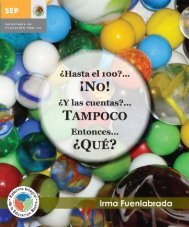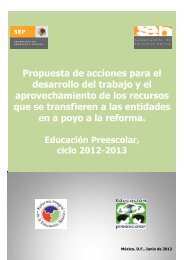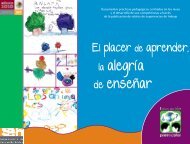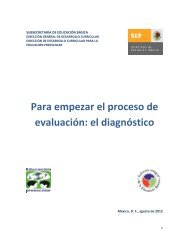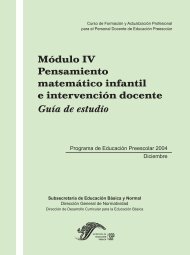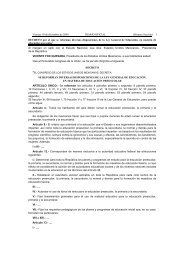- Page 1 and 2:
ACUERDO NÚMERO 592 POR EL QUE SE E
- Page 3 and 4:
ACUERDO NÚMERO 592 POR EL QUE SE E
- Page 5 and 6:
CONSIDERANDO Índice acuerdo núMer
- Page 7 and 8:
x. la GeStión educativa y de loS a
- Page 9:
xI.6.10. estándares de HabILIdades
- Page 12 and 13:
Que, de conformidad con dicho orden
- Page 14 and 15:
español o alguna de las lenguas in
- Page 16 and 17:
preeminencia, hasta llegar a la eco
- Page 18 and 19:
innovar prácticas y propuestas ped
- Page 20 and 21:
Lo anterior requiere: • Cumplir c
- Page 22 and 23:
Con este propósito se realizaron l
- Page 24 and 25:
Educativa. El referente internacion
- Page 26 and 27:
pecialistas del área de conocimien
- Page 28 and 29:
XXII. De lo anterior también se de
- Page 30 and 31:
a lo largo de su vida, desarrollar
- Page 32 and 33:
I.5. poner énfasIs en el desarroll
- Page 34 and 35:
colares y educativas, en sus distin
- Page 36 and 37:
Asimismo, y con el fin de dar a con
- Page 38 and 39:
Para atender a los alumnos que, por
- Page 40 and 41:
I.12. la tutoría y la asesoría aC
- Page 42 and 43:
Como resultado del proceso de forma
- Page 44 and 45:
Habilidades digitales estándares C
- Page 46 and 47:
vI. CAMPoS dE FoRMACIÓn PARA LA Ed
- Page 48 and 49:
La educación preescolar también f
- Page 50 and 51:
las demás lenguas indígenas. Se c
- Page 52 and 53:
VI.2.2. matemátICas en prImarIa y
- Page 54 and 55:
VI.3.4. La entIdad donde VIVo Para
- Page 56 and 57:
La Secretaría de Educación Públi
- Page 58 and 59:
formas intencionadas de movimiento.
- Page 60 and 61:
textualización de aquéllas que se
- Page 62 and 63:
Asimismo, son: • Nacionales: - Se
- Page 64 and 65:
Los Marcos Curriculares rompen con
- Page 66 and 67:
particular. En la actualidad, las p
- Page 68 and 69:
Para cumplir los Estándares de Hab
- Page 70 and 71:
• Definición de tres modelos de
- Page 72 and 73:
propicios que atiendan a la diversi
- Page 74 and 75:
Resulta claro que la propuesta curr
- Page 76 and 77:
dIstrIbuCIón del tIempo de trabajo
- Page 78 and 79:
Para educación secundaria técnica
- Page 80 and 81:
dIstrIbuCIón del tIempo de trabajo
- Page 82 and 83:
dIstrIbuCIón del tIempo de trabajo
- Page 84 and 85:
x.7. GestIón del tIempo propuesto
- Page 86 and 87:
seCundarIa La jornada semanal de la
- Page 88 and 89:
nIvel 3 de desempeño pIsa. matemá
- Page 90 and 91:
Se organizan en: 1. Sentido numéri
- Page 92 and 93:
xI.3. prImer perIodo esColar, al Co
- Page 94 and 95:
3.11. Narra anécdotas, historias,
- Page 96 and 97:
aspeCto: lenGuaje oral CompetenCIa
- Page 98 and 99:
aspeCto: lenGuaje esCrIto CompetenC
- Page 100 and 101:
1.1.4. Explorar el significado que
- Page 102 and 103:
4. Actitudes hacia el lenguaje y la
- Page 104 and 105:
práCtICa soCIal del lenGuaje: part
- Page 106 and 107:
práCtICa soCIal del lenGuaje: seGu
- Page 108 and 109:
práCtICa soCIal del lenGuaje: form
- Page 110 and 111:
práCtICa soCIal del lenGuaje: part
- Page 112 and 113:
práCtICa soCIal del lenGuaje: desC
- Page 114 and 115:
1.3. Representación de informació
- Page 116 and 117:
3.5. Tiene una actitud favorable ha
- Page 118 and 119:
aspeCto: forma, espaCIo y medIda Co
- Page 120 and 121:
2.3. Entiende el uso de algunos rec
- Page 122 and 123:
aspeCto: mundo natural CompetenCIa
- Page 124 and 125:
aspeCto: Cultura y vIda soCIal Comp
- Page 126 and 127:
aspeCto: promoCIón de la salud Com
- Page 128 and 129:
aspeCto: relaCIones Interpersonales
- Page 130 and 131:
aspeCto: expresIón Corporal y apre
- Page 132 and 133:
aspeCto: expresIón dramátICa y ap
- Page 134 and 135:
2.2. Entiende que los diferentes ti
- Page 136 and 137:
• Estudios han probado que un bue
- Page 138 and 139:
práCtICa soCIal del lenGuaje: Iden
- Page 140 and 141:
práCtICa soCIal del lenGuaje: reCo
- Page 142 and 143:
Bloque III práCtICa soCIal del len
- Page 144 and 145:
práCtICa soCIal del lenGuaje: anun
- Page 146 and 147:
práCtICa soCIal del lenGuaje: rees
- Page 148 and 149:
Bloque V práCtICa soCIal del lenGu
- Page 150 and 151:
Segundo grado Bloque I práCtICa so
- Page 152 and 153:
práCtICa soCIal del lenGuaje: elab
- Page 154 and 155:
práCtICa soCIal del lenGuaje: modI
- Page 156 and 157:
Bloque III práCtICa soCIal del len
- Page 158 and 159:
práCtICa soCIal del lenGuaje: elab
- Page 160 and 161:
práCtICa soCIal del lenGuaje: elab
- Page 162 and 163:
Bloque V práCtICa soCIal del lenGu
- Page 164 and 165:
práCtICa soCIal del lenGuaje: Cont
- Page 166 and 167:
Bloque II práCtICa soCIal del lenG
- Page 168 and 169:
práCtICa soCIal del lenGuaje: Inve
- Page 170 and 171:
práCtICa soCIal del lenGuaje: esCr
- Page 172 and 173:
Bloque IV práCtICa soCIal del lenG
- Page 174 and 175:
práCtICa soCIal del lenGuaje: dIfu
- Page 176 and 177:
práCtICa soCIal del lenGuaje: esCr
- Page 178 and 179:
En la definición de un modelo de i
- Page 180 and 181:
1.1.4. Detectar palabras semejantes
- Page 182 and 183:
3.6. Vincular imágenes con palabra
- Page 184 and 185:
práCtICa soCIal del lenGuaje: part
- Page 186 and 187:
práCtICa soCIal del lenGuaje: seGu
- Page 188 and 189:
práCtICa soCIal del lenGuaje: form
- Page 190 and 191:
práCtICa soCIal del lenGuaje: part
- Page 192 and 193:
práCtICa soCIal del lenGuaje: desC
- Page 194 and 195:
práCtICa soCIal del lenGuaje: part
- Page 196 and 197:
práCtICa soCIal del lenGuaje: seGu
- Page 198 and 199:
Bloque III práCtICa soCIal del len
- Page 200 and 201:
práCtICa soCIal del lenGuaje: part
- Page 202 and 203:
práCtICa soCIal del lenGuaje: desC
- Page 204 and 205:
práCtICa soCIal del lenGuaje: leer
- Page 206 and 207:
práCtICa soCIal del lenGuaje: ofre
- Page 208 and 209:
práCtICa soCIal del lenGuaje: form
- Page 210 and 211:
práCtICa soCIal del lenGuaje: leer
- Page 212 and 213:
práCtICa soCIal del lenGuaje: Inte
- Page 214 and 215:
El Estándar Curricular para este e
- Page 216 and 217:
Bloque IV CompetenCIas que se favor
- Page 218 and 219:
Bloque III CompetenCIas que se favo
- Page 220 and 221:
Bloque II CompetenCIas que se favor
- Page 222 and 223:
xI.4.9. estándares de CIenCIas Est
- Page 224 and 225:
4.4. Muestra disposición y toma de
- Page 226 and 227:
Bloque IV. Las actividades del luga
- Page 228 and 229:
Bloque II. Exploramos la naturaleza
- Page 230 and 231:
Bloque V. Juntos mejoramos nuestra
- Page 232 and 233:
Bloque II. ¿Cómo somos y cómo vi
- Page 234 and 235:
Bloque IV. ¿Por qué se transforma
- Page 236 and 237:
a) Utilizar el chat en ambientes co
- Page 238 and 239:
Bloque III. La Conquista, el Virrei
- Page 240 and 241:
xI.4.13. aprendIzajes esperados de
- Page 242 and 243:
Bloque III. Conozco y respeto a las
- Page 244 and 245:
Bloque V. Dialogamos para resolver
- Page 246 and 247:
Bloque II. Mis responsabilidades y
- Page 248 and 249:
Bloque IV. Reglas para la convivenc
- Page 250 and 251:
Tercer grado Bloque I. Niñas y ni
- Page 252 and 253:
Bloque III. El cuidado del ambiente
- Page 254 and 255:
Bloque V. Aprendemos a organizarnos
- Page 256 and 257:
Bloque III. Lo que puedo hacer con
- Page 258 and 259:
Bloque II. Ahora sí, ¡juguemos a
- Page 260 and 261:
Tercer grado Bloque I. Mi cuerpo en
- Page 262 and 263:
Bloque V. Detectives del cuerpo Com
- Page 264 and 265:
Bloque II CompetenCIa que se favore
- Page 266 and 267:
Bloque IV CompetenCIa que se favore
- Page 268 and 269:
Segundo grado Bloque I CompetenCIa
- Page 270 and 271:
Bloque III CompetenCIa que se favor
- Page 272 and 273:
Bloque V CompetenCIa que se favoreC
- Page 274 and 275:
Bloque II CompetenCIa que se favore
- Page 276 and 277:
Bloque IV CompetenCIa que se favore
- Page 278 and 279:
xI.5. terCer perIodo esColar, al Co
- Page 280 and 281:
3. Participación en eventos comuni
- Page 282 and 283:
nIvel Grado Primaria 272 palabras l
- Page 284 and 285:
práCtICa soCIal del lenGuaje: esCr
- Page 286 and 287:
Bloque II práCtICa soCIal del lenG
- Page 288 and 289:
práCtICa soCIal del lenGuaje: esCr
- Page 290 and 291:
práCtICa soCIal del lenGuaje: anal
- Page 292 and 293:
práCtICa soCIal del lenGuaje: esCr
- Page 294 and 295:
Bloque V práCtICa soCIal del lenGu
- Page 296 and 297:
Quinto grado Bloque I práCtICa soC
- Page 298 and 299:
práCtICa soCIal del lenGuaje: elab
- Page 300 and 301:
práCtICa soCIal del lenGuaje: elab
- Page 302 and 303:
Bloque III práCtICa soCIal del len
- Page 304 and 305:
Bloque IV práCtICa soCIal del lenG
- Page 306 and 307:
práCtICa soCIal del lenGuaje: repo
- Page 308 and 309:
práCtICa soCIal del lenGuaje: elab
- Page 310 and 311:
práCtICa soCIal del lenGuaje: esCr
- Page 312 and 313:
Bloque II práCtICa soCIal del lenG
- Page 314 and 315:
práCtICa soCIal del lenGuaje: elab
- Page 316 and 317:
práCtICa soCIal del lenGuaje: adap
- Page 318 and 319:
Bloque IV práCtICa soCIal del lenG
- Page 320 and 321:
práCtICa soCIal del lenGuaje: esCr
- Page 322 and 323:
práCtICa soCIal del lenGuaje: elab
- Page 324 and 325:
• Identifica diferentes modos de
- Page 326 and 327:
1. Comprensión La comprensión en
- Page 328 and 329:
3. Multimodalidad 3.1. Reproducir c
- Page 330 and 331:
práCtICa soCIal del lenGuaje: leer
- Page 332 and 333:
práCtICa soCIal del lenGuaje: ofre
- Page 334 and 335:
práCtICa soCIal del lenGuaje: form
- Page 336 and 337:
práCtICa soCIal del lenGuaje: leer
- Page 338 and 339:
práCtICa soCIal del lenGuaje: Inte
- Page 340 and 341:
práCtICa soCIal del lenGuaje: leer
- Page 342 and 343:
práCtICa soCIal del lenGuaje: esCu
- Page 344 and 345:
práCtICa soCIal del lenGuaje: leer
- Page 346 and 347:
práCtICa soCIal del lenGuaje: leer
- Page 348 and 349:
práCtICa soCIal del lenGuaje: seGu
- Page 350 and 351:
práCtICa soCIal del lenGuaje: leer
- Page 352 and 353:
práCtICa soCIal del lenGuaje: esCu
- Page 354 and 355:
práCtICa soCIal del lenGuaje: leer
- Page 356 and 357:
práCtICa soCIal del lenGuaje: leer
- Page 358 and 359:
práCtICa soCIal del lenGuaje: seGu
- Page 360 and 361:
2. Forma, espacio y medida Durante
- Page 362 and 363:
xI.5.8. aprendIzajes esperados de m
- Page 364 and 365:
Bloque III CompetenCIas que se favo
- Page 366 and 367:
Bloque V CompetenCIas que se favore
- Page 368 and 369:
Bloque II CompetenCIas que se favor
- Page 370 and 371:
Bloque V CompetenCIas que se favore
- Page 372 and 373:
Bloque II CompetenCIas que se favor
- Page 374 and 375:
Bloque V CompetenCIas que se favore
- Page 376 and 377:
1.11. Describe la formación de ecl
- Page 378 and 379:
xI.5.10. aprendIzajes esperados de
- Page 380 and 381:
Bloque III. ¿Cómo son los materia
- Page 382 and 383:
Bloque V. ¿Cómo conocemos? El con
- Page 384 and 385:
Bloque II. ¿Cómo somos y cómo vi
- Page 386 and 387:
Bloque IV. ¿Por qué se transforma
- Page 388 and 389:
Sexto grado Bloque I. ¿Cómo mante
- Page 390 and 391:
Bloque III. ¿Cómo son los materia
- Page 392 and 393:
Bloque V. ¿Cómo conocemos? El con
- Page 394 and 395:
xI.5.12. aprendIzajes esperados de
- Page 396 and 397:
Bloque IV. Características económ
- Page 398 and 399:
Quinto grado Bloque I. Los continen
- Page 400 and 401:
Bloque IV. Características económ
- Page 402 and 403:
Bloque II. La Tierra y su naturalez
- Page 404 and 405:
Bloque V. Retos del mundo eje temá
- Page 406 and 407:
Bloque II. Mesoamérica CompetenCIa
- Page 408 and 409:
Bloque IV. La formación de una nue
- Page 410 and 411:
Quinto grado Bloque I. Los primeros
- Page 412 and 413:
Bloque III. Del Porfiriato a la Rev
- Page 414 and 415:
Bloque V. México al final del sigl
- Page 416 and 417:
Bloque II. Las civilizaciones agrí
- Page 418 and 419:
Bloque IV. La Edad Media en Europa
- Page 420 and 421:
xI.5.14. aprendIzajes esperados de
- Page 422 and 423:
Bloque III. México: un país diver
- Page 424 and 425:
Bloque V. Participación ciudadana
- Page 426 and 427:
Bloque II. Niñas y niños que apre
- Page 428 and 429:
Bloque IV. Vida y gobierno democrá
- Page 430 and 431:
Sexto grado Bloque I. De la niñez
- Page 432 and 433:
Bloque III. Los desafíos de las so
- Page 434 and 435: Bloque V. Acontecimientos sociales
- Page 436 and 437: Bloque III. Educando al cuerpo para
- Page 438 and 439: Bloque II. Juego y ritmo en armoní
- Page 440 and 441: Sexto grado Bloque I. La imaginaci
- Page 442 and 443: Bloque V. Compartimos aventuras Com
- Page 444 and 445: Bloque II CompetenCIa que se favore
- Page 446 and 447: Bloque IV CompetenCIa que se favore
- Page 448 and 449: Quinto grado Bloque I CompetenCIa q
- Page 450 and 451: Bloque III CompetenCIa que se favor
- Page 452 and 453: Bloque V CompetenCIa que se favoreC
- Page 454 and 455: Bloque II CompetenCIa que se favore
- Page 456 and 457: Bloque IV CompetenCIa que se favore
- Page 458 and 459: xI.6. Cuarto perIodo esColar, al Co
- Page 460 and 461: 4. Conocimiento del funcionamiento
- Page 462 and 463: xI.6.3. aprendIzajes esperados de e
- Page 464 and 465: práCtICa soCIal del lenGuaje: elab
- Page 466 and 467: práCtICa soCIal del lenGuaje: esCr
- Page 468 and 469: Bloque III práCtICa soCIal del len
- Page 470 and 471: práCtICa soCIal del lenGuaje: esCr
- Page 472 and 473: práCtICa soCIal del lenGuaje: Cono
- Page 474 and 475: Bloque V práCtICa soCIal del lenGu
- Page 476 and 477: Segundo grado Bloque I práCtICa so
- Page 478 and 479: práCtICa soCIal del lenGuaje: anal
- Page 480 and 481: práCtICa soCIal del lenGuaje: esCr
- Page 482 and 483: Bloque III práCtICa soCIal del len
- Page 486 and 487: práCtICa soCIal del lenGuaje: rese
- Page 488 and 489: Bloque V práCtICa soCIal del lenGu
- Page 490 and 491: Tercer grado Bloque I práCtICa soC
- Page 492 and 493: práCtICa soCIal del lenGuaje: anal
- Page 494 and 495: práCtICa soCIal del lenGuaje: elab
- Page 496 and 497: Bloque III práCtICa soCIal del len
- Page 498 and 499: práCtICa soCIal del lenGuaje: real
- Page 500 and 501: práCtICa soCIal del lenGuaje: leCt
- Page 502 and 503: Bloque V práCtICa soCIal del lenGu
- Page 504 and 505: En consecuencia, estos estándares
- Page 506 and 507: 1.2.1. Comprender textos redactados
- Page 508 and 509: 4.5. Reconocer el valor de entreten
- Page 510 and 511: práCtICa soCIal del lenGuaje: leer
- Page 512 and 513: práCtICa soCIal del lenGuaje: Inte
- Page 514 and 515: práCtICa soCIal del lenGuaje: leer
- Page 516 and 517: práCtICa soCIal del lenGuaje: Comp
- Page 518 and 519: práCtICa soCIal del lenGuaje: Inte
- Page 520 and 521: práCtICa soCIal del lenGuaje: leer
- Page 522 and 523: práCtICa soCIal del lenGuaje: Inte
- Page 524 and 525: práCtICa soCIal del lenGuaje: leer
- Page 526 and 527: práCtICa soCIal del lenGuaje: Comp
- Page 528 and 529: práCtICa soCIal del lenGuaje: Inte
- Page 530 and 531: práCtICa soCIal del lenGuaje: leer
- Page 532 and 533: práCtICa soCIal del lenGuaje: Inte
- Page 534 and 535:
práCtICa soCIal del lenGuaje: leer
- Page 536 and 537:
práCtICa soCIal del lenGuaje: Comp
- Page 538 and 539:
práCtICa soCIal del lenGuaje: Inte
- Page 540 and 541:
2. Forma, espacio y medida Este eje
- Page 542 and 543:
xI.6.7. aprendIzajes esperados de m
- Page 544 and 545:
Bloque III CompetenCIas que se favo
- Page 546 and 547:
Bloque V CompetenCIas que se favore
- Page 548 and 549:
Bloque II CompetenCIas que se favor
- Page 550 and 551:
Bloque V CompetenCIas que se favore
- Page 552 and 553:
Bloque II CompetenCIas que se favor
- Page 554 and 555:
Bloque V CompetenCIas que se favore
- Page 556 and 557:
Física Los Estándares Curriculare
- Page 558 and 559:
4. Actitudes asociadas a la ciencia
- Page 560 and 561:
Bloque II. La nutrición como base
- Page 562 and 563:
Bloque IV. La reproducción y la co
- Page 564 and 565:
Segundo grado. Énfasis en Física
- Page 566 and 567:
Bloque III. Un modelo para describi
- Page 568 and 569:
Bloque V. Conocimiento, sociedad y
- Page 570 and 571:
Bloque II. Las propiedades de los m
- Page 572 and 573:
Bloque IV. La formación de nuevos
- Page 574 and 575:
a) Participar en un proyecto de apr
- Page 576 and 577:
Bloque II. Diversidad natural de la
- Page 578 and 579:
Bloque IV. Espacios económicos y d
- Page 580 and 581:
xI.6.12. aprendIzajes esperados de
- Page 582 and 583:
Bloque III. De mediados del siglo X
- Page 584 and 585:
Bloque V. Décadas recientes Compet
- Page 586 and 587:
Bloque II. Nueva España, desde su
- Page 588 and 589:
Bloque IV. La Revolución Mexicana,
- Page 590 and 591:
xI.6.13. aprendIzajes esperados de
- Page 592 and 593:
Bloque III. La dimensión cívica y
- Page 594 and 595:
Bloque V. Hacia la identificación
- Page 596 and 597:
Bloque II. Pensar, decidir y actuar
- Page 598 and 599:
Bloque IV. Participación y ciudada
- Page 600 and 601:
xI.6.14. aprendIzajes esperados de
- Page 602 and 603:
Bloque V. Activo mi cuerpo, cuido m
- Page 604 and 605:
Bloque IV. Acuerdos para solucionar
- Page 606 and 607:
Bloque III. Ajustes y estrategias e
- Page 608 and 609:
Bloque II. ¿Qué es la imagen figu
- Page 610 and 611:
Bloque III. Técnicas de las artes
- Page 612 and 613:
Bloque IV. Arte colectivo CompetenC
- Page 614 and 615:
Bloque IV. Preparación de una danz
- Page 616 and 617:
Bloque III. La danza: territorio co
- Page 618 and 619:
Bloque II. La danza y las otras art
- Page 620 and 621:
músICa Primer grado Bloque I. De l
- Page 622 and 623:
Bloque V. Formas musicales elementa
- Page 624 and 625:
Bloque V. ¿Para qué hacemos músi
- Page 626 and 627:
Bloque V. Sonido, música y tecnolo
- Page 628 and 629:
Bloque III. Las historias que conta
- Page 630 and 631:
Segundo grado Bloque I. La expresiv
- Page 632 and 633:
Bloque V. Estructura dramática y p
- Page 634 and 635:
Bloque II. Escribiendo para la esce
- Page 636 and 637:
ARTÍCULO TERCERO.- La Secretaría
- Page 638 and 639:
atributo que requiere la escuela pa
- Page 640:
SéPTIMO.- La Secretaría de Educac



